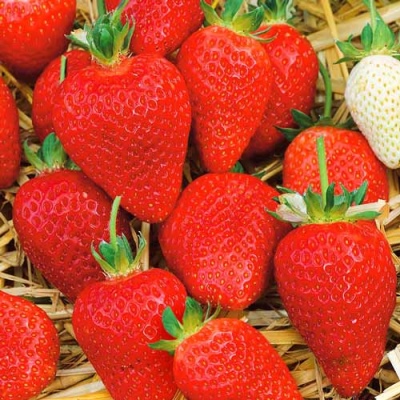
- Authors: Russia
- Taste: super sweet
- The size: large
- Weight: 30-40 gr
- Yield rate: high
- Yield: up to 1 kg per bush
- Repairability: Yes
- Ripening terms: ultra early
- Description of the bush: tall
- Berry color: red-orange
The unusual strawberry Honey Summer, bred by Russian breeders, has managed to fall in love with gardeners for its unique appearance and excellent characteristics of the variety. It is suitable for cultivation in ampelous culture, withstands transportation well, has an excellent presentation. The variety is adapted for many climatic zones, including the Urals and Siberia.
Description of the variety
Strawberries form tall bushes, reaching 20-25 cm. Shoots are formed abundantly, whiskers are long, brush-like, up to 45 cm in length. The variety is distinguished by continuous flowering. Sprawling bushes are covered with dark green leaves with a wrinkled relief plate. The petioles are elongated, they are covered with bright pink flowers, which give the plants a decorative effect.
Ripening terms
Super early, remontant strawberries. Ripens from June until frost, the second wave begins in August or early September, depending on climatic conditions. Bushes bear fruit in the year of planting.
Yield
Can be harvested up to 1 kg per bush. The yield is high.
Berries and their taste
Strawberry fruits of this variety have an unusual red-orange skin tone, juicy and dense pulp without voids. The shape of the berry in the form of an elongated heart looks very attractive. It is large, weighing 30-40 g. The taste is super-sweet. A noticeable aroma of wild strawberries emanates from the berries of the Honey Summer.
Growing features
Honey summer is a variety that grows equally well in greenhouse conditions and in the open field. Planting is done in squares, with a distance between the bushes of 40x40 cm. Planting in pots is also practiced as a balcony plant or a veranda decoration. As a houseplant, it is cultivated in a one-year cycle. The variety is sensitive to the amount of moisture it receives: it needs watering every 3-4 days, especially during prolonged dry periods.




Site selection and soil preparation
To grow the Honey Summer variety, you should take care of choosing a sunny, well-lit place. It is important that the plant is far enough away from groundwater. With their close occurrence, you need to take care of increasing the height of the beds. It is also recommended to drain the planting holes well, fill them with a mixture of wood ash and compost or humus. Sand is added to heavy soils to facilitate their composition.

Pollination
Honey Summer is a self-pollinated variety that does an excellent job of this without outside help. The plant produces flowers with an abundance of pollen.
Top dressing
Strawberry Honey Summer responds well to organic feeding. During the season, you can use root watering with infusion of mullein or chicken droppings, herbs, add wood ash to the soil. Foliar dressing is carried out using a highly diluted alcoholic ammonia solution. To protect against diseases, the use of manganese, boric acid will be useful.

One of the important techniques in strawberry care is feeding. Regular fertilization guarantees a rich harvest. There are several different ways to feed strawberries, and each of them is designed for a specific period of plant development. During flowering, fruiting and after it, feeding should be different.
Frost resistance and the need for shelter
Strawberry bushes Honey summer are winter hardiness. They can be grown without special shelter, but only when temperatures drop to -20 degrees. In colder winters, plants can simply freeze out.

Diseases and pests
Disease resistance is high. The bushes are practically not affected by root cancer or gray rot, spots. In damp climates and in rainy summers, the berries can attract large numbers of slugs. They are harvested by hand, carefully examining the plants. Strawberry Honey Summer has developed genetic resistance to the nematode.

Strawberries are often subject to many dangerous diseases that can seriously undermine their condition. Among the most common are powdery mildew, gray mold, brown spot, anthracnose, and verticillosis. Before buying a variety, you need to inquire about its disease resistance.
Reproduction
The expansion and renewal of the strawberry plantation is done every 3-4 seasons. With seed reproduction, sowing is done in winter, and by spring, young plants are ready for transfer to open ground. Strawberry mustache propagation is also possible. There are enough of them to get new seedlings or to rejuvenate the beds.
If you have mature bushes, you can propagate honey summer strawberries by dividing them. For these purposes, the most abundant fruiting bushes are chosen for 2-3 years. When dividing, each part is formed so that it has a horn and a rosette with a heart and leaves.

Review overview
Honey summer is a promising variety that attracts attention with its abundant fruiting ability, unusual taste and aroma of berries. Those who grow berries for sale appreciated their appearance, which does not spoil during transportation, the large size and the neat shape of each fruit. According to the experience of gardeners, within 3-4 years the yield does not decrease, then a transplant is necessary. Practice has shown that such a regime ensures the optimal frequency of plantation renewal.
There are also negative aspects. According to the reviews of those who have tried the seed method of plant propagation, the germination rate of the Honey Summer is very low. In addition, the variety requires significantly more space in the beds due to the considerable length of the mustache. In cold regions, it is better to harden the bushes before transferring to the ground in order to avoid freezing.


















































































